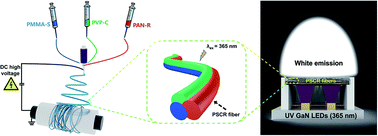White-light-emitting triphasic fibers as a phosphor for light-emitting diodes†
Abstract
White-light-emitting materials have received significant attention because of their potential application in lighting, displays, and sensors. However, it is a challenge to obtain white light from one phosphor, because the basic requirement of the white light emission spectrum is that it should be wide enough to cover the entire visible light region. In this study, we have designed and demonstrated a white-light-emitting PMMA–CBS-127/PVP–coumarin 6/PAN–rhodamine B (PSCR) fibrous membrane, which was prepared through a triphasic electrospinning method. Three luminescent organic dyes, CBS-127 (4.77 wt%, blue), coumarin 6 (0.1 wt%, green), and rhodamine B (0.42 wt%, red), were elaborately selected and doped into PMMA, PVP, and PAN, respectively. The resulting flexible PSCR membranes show white light emission (cover the entire visible-light region from 382 to 700 nm) with Commission Internationale de L'Eclairage (CIE) coordinates of (0.31, 0.32), which is very close to ideal white light with CIE coordinates (0.33, 0.33). In addition, the PSCR membranes maintained high-quality white light emission after about 10 weeks of storage. The PSCR membranes can be used as the phosphor converting layer in white light-emitting diodes (WLEDs) through a remote membrane packaging method. A bright white emission is achieved at an applied voltage of 9 V. Therefore, the results indicate that PSCR membranes are potentially attractive candidates for application in WLEDs and displays.



 Please wait while we load your content...
Please wait while we load your content...